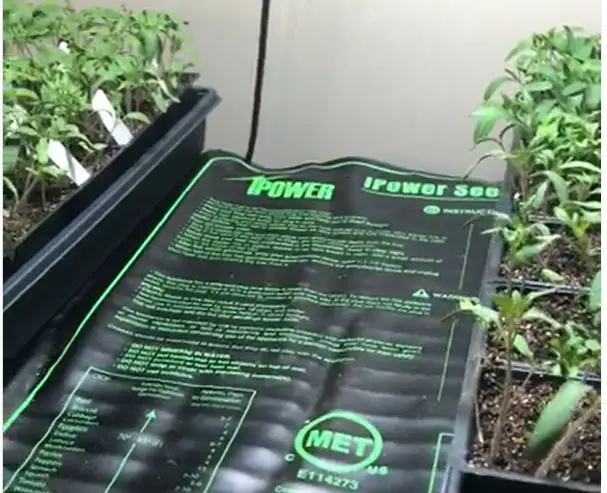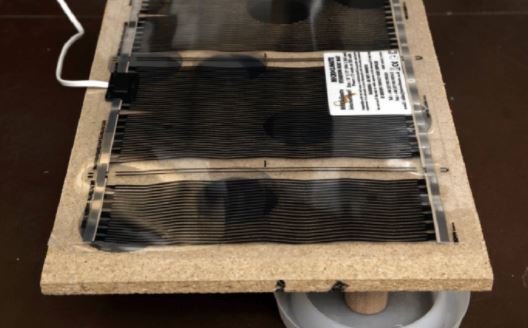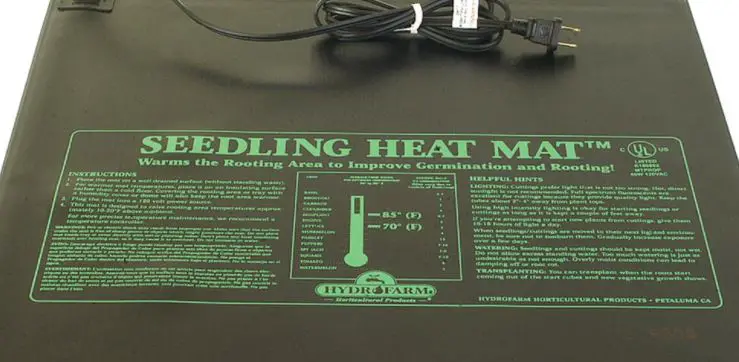How to install a heat mat in a wooden vivarium?
This article will help you understand what a heat mat is, how to properly install one in your vivarium, and why it’s important for the health of your reptile.
A heat mat is an electrical device that emits heat into the environment. It can be used as a supplemental heating source or as the primary heating method in some environments.
Heat mats are most often used with reptiles because they do not need high humidity levels to stay healthy as amphibians or invertebrates do.
Related Posts:
- 7 Best Heat Lamps for Tortoise
- Top 7 Best UVB Bulb for a Sulcata Tortoise
- Best Heat Mat for Leopard Gecko
How to Install a Heat Mat in a Wooden Vivarium?
1. Drill Holes Through the Wooden Vivarium
To install a heat mat in a wooden vivarium, you will need to drill a 10mm hole in the back and about 20mm up from the bottom of your vivarium.
This is where we will drill through to thread our cable through so it can come out somewhere near your basking lamp.
Make sure you use some sealant on the outside of your vivarium where you have drilled this hole to stop any water or substrate from being pushed out.
2. Thread the Heat Mat Cable Through the Heat Mat
Cut 2 lengths of cotton cord just longer than your heat mat, tie a knot in one end of each cord, and thread them through your heat mat.
Thread the cotton cord through the holes you drilled, knotting the ends on the inside of your vivarium to hold it securely in place.
3. Attach the Cotton Cord to the Heat Mat
Next, we need to attach our plug and thermostat probe to the other end of the heat mat.
Pull the cords through the heat mat so that there is just enough inside to easily reach your thermostat when it’s in place.
You’ll need to have a good think about this bit. You don’t want to pull your heat mat out when you’re trying to attach everything.
4. Attach the Thermostat Probe to the Heat Mat
Once you have pulled both ends of the heat mat through your vivarium and out of the hole you drilled in step one, you can attach the thermostat probe to the heat mat.
Push the probe inside your vivarium next to where you plan on placing your basking lamp so that it will be close enough to monitor a high temperature close by.
Thread both plug ends of your cable through the top of your vivarium and plug your heat mat in.

5. Attach the Thermostat Probe to the Probe Input
Now, you need to attach your thermostat probe to the probe input on the back of your thermostat, then attach your basking lamp cord to one of the remaining sockets on the back of the thermostat.
6. Attach the Basking Lamp to the Thermostat
Attach your basking lamp to the other socket on the back of the thermostat and turn it on.
You now need to set your temperature controls. This is done by moving both dials so that they point at each other.
Do not adjust them away from each other as this will just confuse you later!
7. Connect the Basking Lamp to the Wooden Vivarium
You now need to attach your basking light. Cut a small square of foil and fold it over the end of your cable coming through the top of your vivarium.
Using pliers, crimp this tightly around the cable to form an impromptu plug, which you can then plug straight into your thermostat.
8. Connect the Heat Mat to the Thermostat
Your heat mat will now need to be connected up. This is done by taking the two cords that are sticking out of your heat mat and attaching them to the correct inputs on your thermostat.
9. Wait for the Heat Mat to Heat Up
Now, sit back and wait for your heat mat to heat up!
Once it gets around 5 to 10°C above ambient room temperature, you can put your substrate down, place your furniture in, decorate, and move some slates around.
If you have any problems with this setup, contact us for help.
The thermostat operating temperature range of 10 to 30°C adheres to strict regulations of Siroop, a company that produces thermostats.
What Should You Know Before Setting Up Heating Equipment for Reptiles?
Heating equipment works best when placed above the location where you plan for your reptile to “bask” on warmer days or digest its food. This is why heat mats and basking lamps are installed on the screen lid.
The basking spots should be away from any water bowls (or other items) and directly in sunlight only when the sun is high in the sky and for extended periods of time.
If you plan to use a UV lamp with your heating equipment, make sure that they do not touch each other at all. If the UV lamp is closer to the heat mat than 12 to 18 inches for too long, melting can occur.
Always place your UV bulb above your basking spot when using UV/heat combination lamps.
UV light must be in contact with your reptile’s eyes for best results. Reptiles use eyesight to hunt and communicate within their species just like humans.
When using a glass or plastic tank, make sure the heating equipment is installed on the outside of your tank to prevent overheating and melting of your tank walls.
Be careful when selecting a ceramic heater for use with glass/plastic tanks. They can become extremely hot during use and may crack your tank if it’s too close to the surface.
With any heating equipment, make sure you monitor your setup closely after installation and before placing your reptile in its enclosure.
Always overestimate the amount of heat required to keep your animal happy and comfortable or you may find yourself with a sick or dead reptile!

Where Should You Place the Heating Equipment?
- Glass/plastic tanks can be heated from outside of the enclosure if using a ceramic heater. Make sure your heater is compatible with the tank materials before making a purchase to avoid cracking your tank during use. Always allow for ventilation on these types of enclosures.
- Glass or plastic screens must not be used with a heat mat. A heat mat must be placed under a glass or plastic tank to avoid overheating and melting/cracking your tank walls.
- Never use a heat mat without an external thermostat. They can reach temperatures of up to 70°C, far too hot for reptiles to withstand even if the highest temperature is set on your thermostat.
- Substrates must not be used with heat mats. The substrate will become too hot for your reptile to lie on and could cause burns or dehydration through lack of contact with his/her natural environment.
- Never use a heat mat in combination with any other type of heating equipment unless you have tested its compatibility with your setup.
- If you are unsure about anything in this article or with your heating equipment, please feel free to contact us at any time.
We are here for you and our goal is to provide the best possible information to keep your reptile safe and healthy!

Conclusion
It’s important to ensure that the reptile owner has all of the necessary information about how best to care for their pet.
If you’re not sure what type of heat mat is appropriate, or if your vivarium doesn’t have a built-in thermostat, we recommend incorporating one into your setup before it becomes an issue.
For more tips on caring for reptiles and installing heating mats in wooden enclosures, check out our other blog posts!
Further Reading:
- 7 Best Lighting for Chameleons
- 9 Best Heat Lamps for Bearded Dragon
- 5 Best Bearded Dragon Lighting Setups
- Best UVB Bulbs for Sulcata Tortoise


